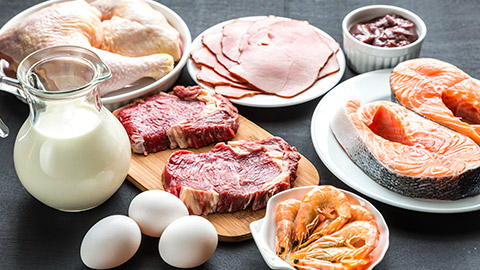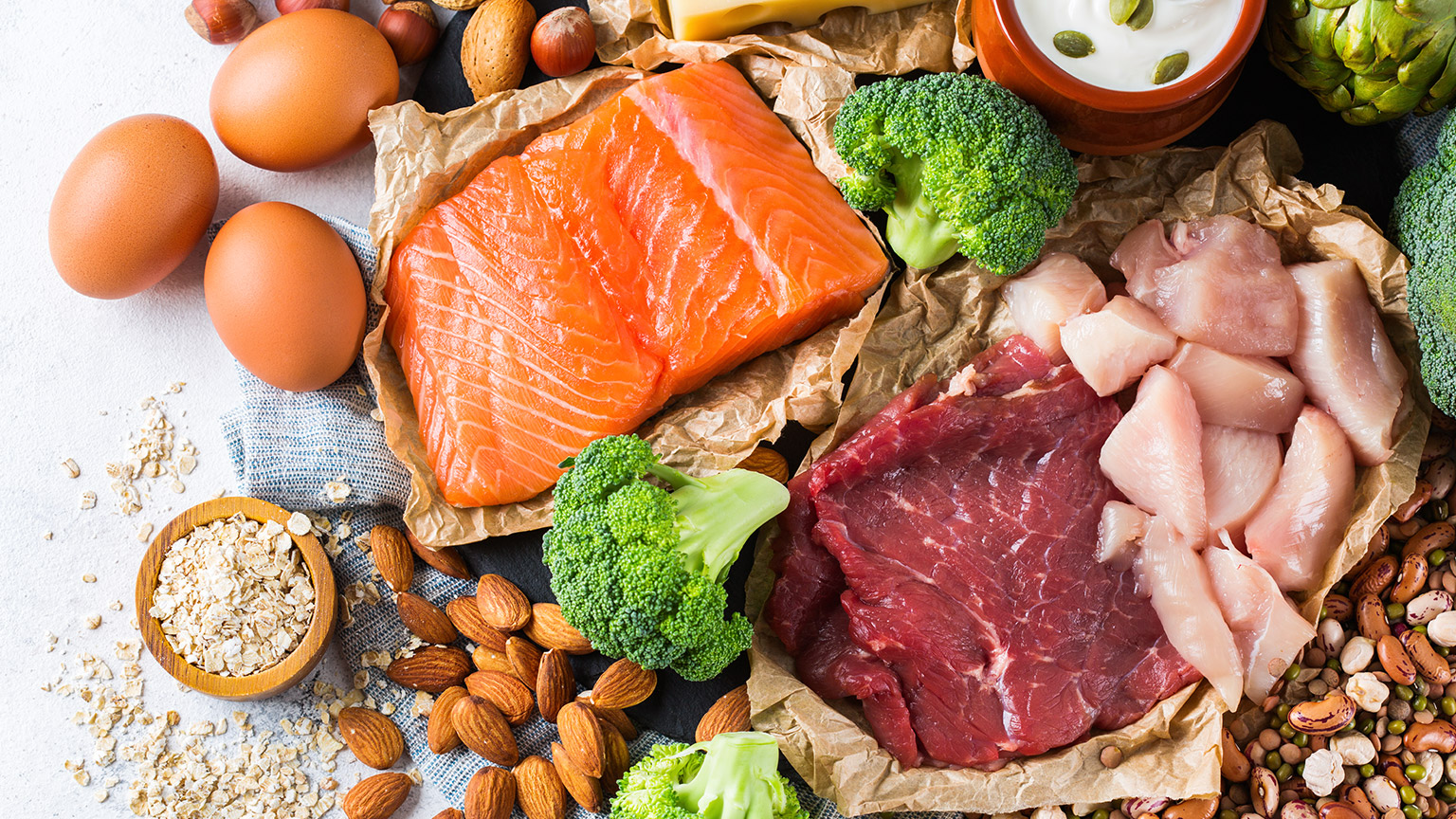In this topic, we focus on the role of protein and it's benefits within diet and exercise. You will learn:
- protein structure and function
- digestion, absorption, and storage
- protein needs and consumption
- protein and exercise
Terminology and vocabulary reference guide
As an allied health professional, you need to be familiar with terms associated with the significance of protein and to correctly (and confidently) discuss it’s role within nutrition with clients, your colleagues, and other allied health professionals. You will be introduced to many terms and definitions. Add any unfamiliar terms to your own vocabulary reference guide.
Activities
There are activities and an automated quiz at the end of this topic. These are not part of your assessment but will provide practical experience that will help you in your work and help you prepare for your formal assessment.

Protein is one of 3 macronutrients (carbohydrates, protein and fats), however, one key difference of protein is protein is less seen as a fuel source and more as a vital nutrient required for muscle repair and growth. This is a huge role for protein however its properties are not limited to just one skill, protein has a few responsibilities within the body such as: ensuring the repair and recovery of body tissue( beneficial with physical activity), production of hormones, enzymes and the transportation of molecules for almost everything in the body!
Proteins are complex organic compounds comprised of carbon, hydrogen, oxygen and nitrogen. They are composed of chains of tightly bound amino acids, the building blocks of protein, in order for proteins to provide us with energy and nutrients, they must first be broken down into small chains of and individual amino acids. Amino acids are the building blocks and storage form of proteins with twenty in total. 9 of these cannot be made by the body and therefore become an essential part of the diet. Protein provides 4 cal/g.
Check out this 2-minute video and gauge an understanding of different classifications of protein.
Complete proteins vs incomplete proteins
Food that supplies nine of the essential proteins is known as a complete protein. Complete proteins are commonly found in animal products such as beef, lamb, pork, chicken, fish, eggs, milk, and milk products.
Food that that does not supply all of the essential amino acids is known as an incomplete protein. Examples of incomplete proteins are grains, fruit, and vegetables- to form a complete protein, add plant proteins, and voila a complete protein!

Digestion
Digestion is the process of which the body breaks down food eaten in order to produce nutrients from carbohydrates, proteins, and fats we achieve via our diet. The digestion process begins in the mouth and ends at the anus. The mouth helps with making the food we eat soluble and easy to swallow, this process begins with the enzyme-rich saliva produced in the mouth, and the teeth which mechanically breaking down our food. When a protein source arrives in the stomach, this stimulates hydrochloric acid and other enzymes present (pepsin) in the stomach to break down the protein into smaller chains of amino acids, this is further aided by the muscular contractions of the stomach (peristalsis). Upon leaving the stomach, the next stop is the small intestine where most of the absorption takes place. These protein-based nutrients, amino acids, are distributed into the bloodstream where they are distributed and used for growth, energy, and repair.

Stages of Digestion
- Cephalic: mechanical chewing, wetting food with saliva in the mouth and swallowing of food. Saliva starts digesting carbohydrates.
- Swallowing: after being swallowed, food enters the esophagus. Peristaltic propulsion of food through the esophagus into the stomach.
- Stomach: digestion of proteins using gastric acid and other digestive juices in the stomach. Evacuation of food into the duodenum.
- Small intestine: the liver and pancreas produce digestive juices and enzymes to digest food. Digestion of carbohydrates, fats, polypeptides, nucleic acids. Absorption of amino acids, peptides, glucose, fructose, glycerin, Peristaltic propulsion of food in along toward the large intestine.
- Absorption: in the large intestine fermentation of the digestible substance by intestinal flora, synthesis of vitamins. Absorption of water and glucose, fructose, vitamins and minerals.
- Waste elimination: solid waste products from digestion move into the colon and leave the body via bowel movements.
- The mouth: Chews and moistens food and mixes food with saliva making it easy to swallow, mechanically supported by the teeth which work to grind the food into smaller pieces.
- The stomach: Stomach acids uncoil protein with an enzyme called pepsin which is the active protein-digesting enzyme. Pepsin assists with breaking down the protein into smaller chains which are then distributed into the small intestine.
- The pancreas: Enzymes released by the pancreas further support the breakdown of protein into the smaller, amino acid-based components
- Small intestine: Enzymes released by the pancreas hydrolyse peptides. Peptides are two or more amino acids that are linked together. It is here in the small intestine the final stage of digestion takes place and they are ready to be absorbed.
- The liver: Amino acids are absorbed into the portal vein (of the liver) and transported to the liver where the amino acids then enter the bloodstream.
- The anus: Any excess bi-products of digestion that are not required by the body are eliminated from the body via urine and the faeces. In a general, healthy adult, typically there is a little dietary protein present in the faeces as it has been absorbed by the cells of the body.
Absorption
Most of the absorption of protein takes place in the small intestine. After completing the final stage of digestion, the peptides undergo a chemical breakdown to smaller, singular amino acid structures (known as polypeptides) in order to begin the process of absorption. These polypeptides are the singular subcomponents of protein, amino acids which are very small which means they are able to be absorbed through the lining of the small intestine and into the bloodstream where they are used for growth, energy, and repair.
Taking a short break from reading, below is a 7-minute video for you to watch with a visual representation of the process of which digestion and absorption take place. It contains some important information regarding the 'portal vein' as the gateway into the liver.
Storage
Once the protein has been digested and absorbed, it then needs to be stored. Sites of storage are:
- In the liver: the liver has "amino acid pools", it is in these pools where it can be converted into enzymes, hormones, and muscle repair
- Muscle: approximately 50% of the stored protein in the body is located in the muscle, this is then used for structural tissues such as skin and bone
- Adipose Tissue (body fat): which is where excess protein intake is stored
High protein diets
Consider the following factors before making adjustments to increase dietary protein levels;
Weight loss: Protein provides is with the feeling of being full, ( satiety), so when it is consumed in appropriate amounts it can lead to the consumption of less total calories, which can result in weight loss.
Weight gain: While some foods can be high in protein they can also be high in fat; and if this is the case, it can lead to excess calorie intake and therefore result in weight gain.
Calcium excretion: Diets that are high in protein can lead to calcium excretion in the form of extra urination. The extra urination takes place in order to remove excess nitrogen which can then deplete key electrolytes and calcium is one of them. When calcium is diminished it could lead to bone density reduction.
Raised cholesterol levels: Animal products while high in protein can also be higher in cholesterol which could then play a role in heart disease.
High Protein Diet Considerations
When consulting/educating a client regarding a high protein diet, there are quite a few factors that will need to be considered. Some of these include:
Energy: energy and performance levels may deplete as other nutrients are utilised ( for example, carbohydrates ( CHO)). Protein is filling and may prevent the consumption of CHO. In this case, during exercise, if carbohydrates run out, protein stores could be used for energy resulting in a reduction of lean body mass.
Kidneys: excess dietary protein which is not stored by the body, is excreted in the urine which is produced by the kidney. Therefore, higher dietary protein levels can place additional strain on the kidney as urine will be produced more often in order to remove the excess protein.
Low protein diet
Low protein diets can have serious implications on the body, some of these include:
- stunted growth which occurs from implications of the repair of muscles, not only can it delay growth but it can also prevent it.
- oedema, which is identified by swollen and puffy skin, is also a classic symptom of kwashiorkor (a form of severe protein malnutrition).
- skin, hair and nail deficiencies. Low protein levels can cause redness, flaky skin and depigmentation also resulting in weak nails and hair loss
- loss of muscle mass, this is typically due to less protein being available to muscular repair and also is protein has been called upon in an emergency and a backup fuel source.
- greater risk of bone fractures: this occurs as the density and strength of the bones are diminished
- increased severity of infections: as the body’s immune system becomes weakened by a lack of antibodies this poses a great risk to booth obtaining an infection and the severity of this.
- fatty liver: an accumulation of fat within the liver. If this is left untreated it can lead to fatty liver disease

Vegetarians
Many vegetables are incomplete proteins. Taking this into consideration, individuals on a vegetarian diet may need to consider supplementation in order to ensure their protein requirements are being met. Advising these individuals with the knowledge of the importance of a mixture of coloured fruit and vegetables can assist with assuring they are receiving a sufficient amount of protein. An example of this could be combining vegetables such as broccoli, cauliflower, and spinach (just to name a few!) with foods with higher protein levels such as eggs, legumes, and nuts.
Pregnancy
During pregnancy, an increase in protein is recommended in order to assist with foetal growth. Pregnant women should increase their protein to 1.1g per kg of body weight.
Protein Supplements
- Where possible, protein supplements should not replace real food
- The average person can only process and absorb around 30g of protein at one sitting
- Protein supplements are the most useful post-workout for easy ingestion. Some great examples of these supplements are that which come from milk fat, whey, egg, soy (95%). There are also options for 100% plant proteins such as pea protein or lactose-free whey proteins.
Top non-meat protein sources
From the following selection of images below, you will see a range of different food and their protein levels, this information will support you in giving effective and accurate nutritional advice to your clients; particularly if they have been advised to or have chosen a vegetarian or vegan diet.
Important to note: the food products are not exclusive to any particular diet choice, they can be incorporated with all diets.

The activity below is based on protein needs and consumption.
Amount of protein required
When calculating the required amount of protein, it all depends on the individual’s weight ( measured in Kilograms, Kg), the physical training or activity they participate in, and their personal goals. Consider that protein is a minor fuel source primarily used during endurance exercise when carbohydrates run out. Protein is primarily needed for repair of lean body tissue that can be damaged during training.
Protein needs vary for different individuals and specific groups of people require extra protein depending on their lifestyle, for example, sportspeople, pregnant women, children/adolescents. This will all need to be considered when educating your clients on the importance of the quantity of protein in their diet. Typically, though, the range is 12-20% of the energy that is consumed. When looking at a healthy diet, 0.8g/kg of body weight per day is sufficient for non -athletes and they will need to eat high-quality proteins. Plant-based proteins are quite common; especially for those on a vegan diet. With this in mind, it is best to eat plant-based proteins in combination to aid with complexity. For example, rice and chickpeas, bread, and beans- the more colourful the plate the better; aim for as many colours as possible!
When you are consulting with a client you will need to determine the following before making any calculations for their protein requirements:
- what type of training is performed?
- how often is it performed?
- what is your client's current weight?
- what is your client's goal weight?
General daily protein recommendations
The list provided breaks down a generalised daily protein recommendation. Remember lifestyle choices can influence these; these are provided to give you a guide on where, to begin with calculating the amount of protein these groups would require.
| Client profile | Suggested daily protein/weight ratio |
|---|---|
| General population (doing some fitness) | 1g/Kg |
| Child | 2g/Kg |
| Adolescent athlete | 2g/Kg |
| Strength | 1.6-1.7g/Kg |
| Endurance | 1.2-1.4g/Kg |
| Pregnant | 1-1.2g/Kg |
| Adult | 0.8g/Kg |
Scenario:
Mary is a new client of yours and has asked you to help her determine her optimal protein intake for her general exercise routine. What information would you need from Sylvia to be able to calculate her daily protein intake using the table above? (A- her age, training goals, and her weight in Kg).
Mary is 32 years of age, weighs 55kg, and has not long begun her training regime, at present she does 2 hours of training a week. According to the table above, Mary would fall into either “general population” or “adult”. As she has just begun her training regime, we will opt to use the details for the “general population” however there is not a significant difference in protein, therefore, either calculation could be used in this case
Mary, therefore, should be ingesting 1g of protein for every kilo of her body weight, this looks like:
Her recommended daily protein intake is:
55kg X 1g = 55g PRO/day

Children and adolescents - 2g/Kg
Children and adolescents are growing at an accelerated rate and often go through growth spurts. It is therefore fundamental they receive more protein in order to keep up with the rate at which they are growing.

Strength Athlete - 1.6-1.7g/kg
Strength athletes engage in activity which requires an emphasis on power and strength within physiological training of muscle. In this case, they often eat too much protein as heavy training requires 1.6-1.7g/kg a day and uses protein for repair, energy, and recovery.

Endurance Athletes - 1.2-1.4g/kg
An endurance athlete participates in physical activity for prolonged durations of time. In this case, they commonly eat too little protein as they need a source of energy that can sustain them and ensure they achieve maximum performance.
calculating protein for an endurance athlete:
- general training 1g/kg/day
- heavy training 1.2-1.6g/kg/day
- extreme exercise loads 2g/kg/day
- needed for repair, energy and recovery
While the above values are useful for calculating requirements. Amounts needed can fluctuate depending on the length of season and training load.
Groups and protein intake
Below you will find groups of individuals along with recommended protein intakes in grams(g), kilograms(Kgs) per day.
| Athlete Group |
Protein intake (g/Kg/day) |
|---|---|
| Sedentary men and women | 0.8-1.0 |
| Elite male endurance athletes | 1.6 |
| Moderate intensity endurance athlete (training 4-5 times/ week for 45-60min) | 1.2 |
| Recreational endurance athletes (training 4-5 times/ week for 30 mins @ <55% VO2 max) | 0.8-1.0 |
| Football, power sports | 1.4-1.7 |
| Resistance athletes (early training) | 1.5-1.7 |
| Resistance athletes (steady state) | 1.0-1.2 |
| Female athletes | ~ 15% lower than male athletes (this is reflective of decreased levels of lean muscle mass in comparison to males) |
Considerations
- these calculations have been factored in to distinguish between moderate intensity and elite level athletes, demonstrating their differing levels of endurance. Note that strength has been broken down into "early training", this means when first starting out and when changing up program intensity/load significantly.
- these figures have been calculated according to individuals who have taken to physical activity and training 4-5 times a week, in the event, it is less than this, the figures will then need to be adjusted to meet the relevant engagement of physical activity.
- these figures are not applicable to those diagnosed with obesity as weight-loss strategies need to be contextualised with their needs not being consistent with more athletic individuals.
Suggestions to support exercise
- Most daily food intakes contain well above the recommended requirement for protein.
- Post-training meals should include some protein. This can help to restore muscle glycogen levels, repair muscle tissue, and may help encourage gain in lean body mass.
- Recommended - 20-30g of protein in post event meal. Very little evidence suggest that consuming more than 30g of protein in 1 sitting gives additional benefit (unless carrying large amounts of additional muscle mass).
- Filling up on protein in the pre-exercise window may reduce appetite because the body's preferred source of fuel for training is carbs, and this will negatively impact exercise performance.
- A small amount of protein in the pre-event meal will help with satiety (fullness), meaning we do not feel the need to eat again too close to exercise.
Protein consumption timing
There is a lot of debate surrounding the best time to consume protein. It has long been recognised that there is a very small window, post-workout, for optimal protein intake, however, there are many in the strength training community who are also in support of pre-training and intra-training protein consumption. There are, however, studies that compare pre and post-exercise protein consumption with protein taken in the morning and night (outwith exercise), found no differences in:
- hypertrophy (enlargement of an organ or tissue from the increase in size of its cells)
- strength or other markers of muscle function even though blood levels of amino acids were elevated before and during exercise.
This indicates the amount is more important than the timing therefore it can be said the key to optimal protein synthesis is having a positive Nitrogen balance across the day.

Protein during resistance training
A thought exists that consuming protein before and during training limits muscle protein breakdown (MPB). The theory being that if your body has circulating amino acids in blood while exercising, it will be less likely to use muscle protein for energy when energy reserves from carbohydrates become low.
Few studies have actually been carried out on the consumption of a protein-based supplement during resistance training. One study, however, found that while the ingestion of protein and carbohydrates did enhance total protein balance during exercise and into early recovery, this did not then extend into the overnight fasted period, when most recovery and repair occurs.
Weight training does not diminish the muscle glycogen level to the same extent as cardiovascular training. An average 40 minute weight training session will deplete muscle glycogen stores by only around 40%, considerably less than depletion rates seen as a result of cardiovascular training.
Protein during endurance training
Of all athletic types and capabilities, endurance athletes are the most likely of candidates to run out of fuel supply and experience the breakdown of muscle tissue. Studies have been provided to endurance athletes with the ingestion of protein during a workout. The objective of this was to assess the impact of this macro-nutrient on metabolism and performance. Consumption of protein during endurance exercise did result in an improved whole-body protein balance during and after the exercise session, however, the effects on MPS ( muscle protein synthesis) and MPB ( muscle protein breakdown) was not clear.
Additional studies have shown that protein provisions during exercise can enhance performance. Some evidence indicated that a combination of carbohydrate and protein intake during cycling time trials improved late-exercise time-trial performance. Some of the other studies that had been carried concluded to have shown little to no performance effect. Therefore, there seems to be little reason to recommend the ingestion of protein during aerobic exercise for performance enhancement and there is no discernible benefit in terms of MPS or MPB.
Post-workout protein
With regards to the preferred time of post-workout protein, there is currently a hot debate about whether there is an ‘ideal window’ for protein consumption post-training, the vast majority of research speaks to the importance of post-exercise protein ingestion. This seems to be most important for strength-based training, but studies have also shown improvements in recovery and maintenance of lean body tissue in endurance athletes.
There is conclusive evidence that consumption of protein alongside easily absorbed carbs may enhance the rate of amino acid delivery to muscle, as insulin plays a role in shuttling amino acids into muscle, in the same manner, it does glucose.
In this topic, we focused on the significance of protein within the body, terminology, and key terms. You learnt about:
- the structure and function of protein
- how protein is digested, absorbed and stored
- the importance of protein needs and consumption along with the implications of having too little or too much
- examples of where protein consumption may need to differ- including types of meatless proteins
- how to calculate the required amounts of protein so as to best to assist clients
- the role in which protein plays in exercise

